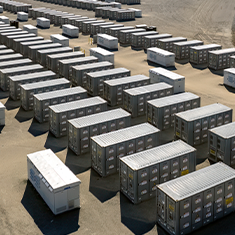
By Mike Schutz, director of renewables & power delivery
Standalone battery storage was something many developers kept on the back burner. They weren’t ignored but, in many portfolios, battery energy storage systems (BESS) were something tied into larger solar or wind developments.
That is changing, and quickly, after the One Big Beautiful Bill Act (HR1) passed. While the bill rolled back federal tax credits for solar, wind and EV infrastructure, it left BESS untouched. That one detail has flipped priorities for a lot of developers — putting storage front and center.
Not because it’s easier. But because it’s one of the few technologies that still benefits from stable incentives.
Policy certainty, grid urgency
Federal tax credits for solar and wind are set to sunset within the next year or so, while current incentives for BESS remain in place through 2033. That extended timeline gives storage projects a level of policy stability that’s becoming harder to find. In a market where financing is tightening and schedules are increasingly unpredictable, that kind of certainty carries weight.
It’s not just about incentives, though. Grid conditions are a major factor, especially in states like Texas and California, where utilities need flexible, fast-response solutions to manage peak demand and shifting energy mixes. BESS is stepping in to fill that role.
Add to that the fact that many states offer their own incentives on top of the federal credit, and it’s clear why storage is gaining momentum. Developers are following the economics, yes — but they’re also meeting real infrastructure needs.
The storage learning curve
Switching from generation to storage isn’t just a matter of swapping panels for batteries. It’s a different type of project with its own learning curve.
Operations and maintenance are more involved. Fire protection becomes a primary design and permitting concern. Local fire departments are increasingly part of the approval process, and that coordination takes time. On top of that, there’s a growing focus on landscape buffers and noise mitigation, especially in areas near residential neighborhoods.
Community engagement also plays a big role. People are still learning what battery projects are and how they work. Getting ahead of these concerns can make or break a project’s timeline. And finding a consulting partner versed in navigating these roadblocks makes all the difference.
This isn’t a detour
This pivot to storage isn’t a temporary detour. It’s a response to the current incentive landscape and a recognition that the grid needs more flexible, dispatchable assets.
No one’s turning their back on solar, wind or EV, but for now, storage is what’s gaining momentum. As a result, developers are reshuffling priorities and moving BESS projects to the front of the line
The fact that tax credits for storage are secure through 2033 gives the industry a window of stability. That won’t last forever. Supply chains are still tight. Local policy could shift. But right now, there’s opportunity and developers who act on it are better positioned than those waiting for everything to settle.
The market didn’t expect this to be the breakout moment for storage, but it is. And for developers ready to adjust, it’s the next move.
This article first appeared in Solar Power World.



